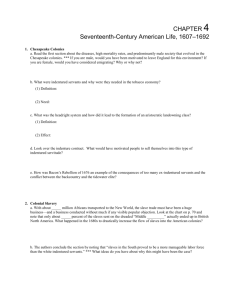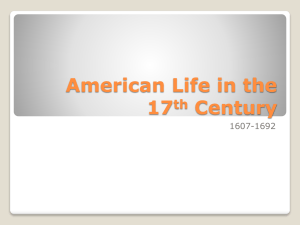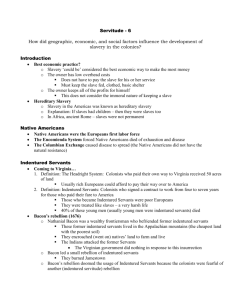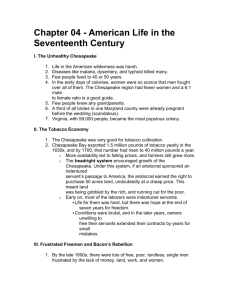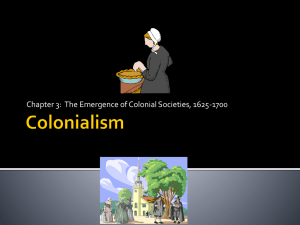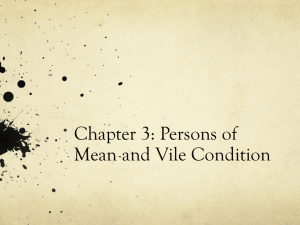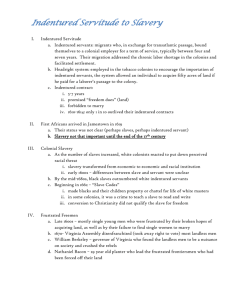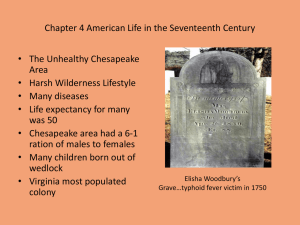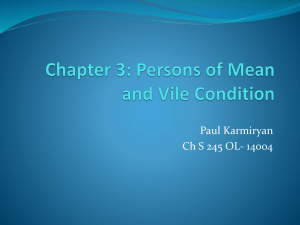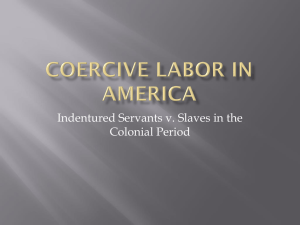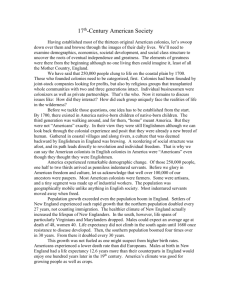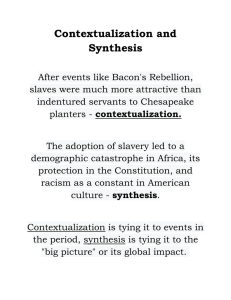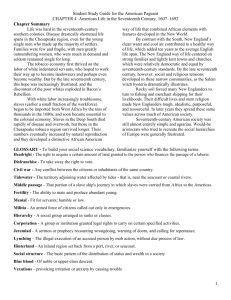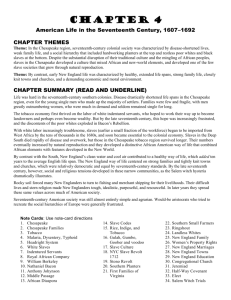American Life in the 17th Century
advertisement
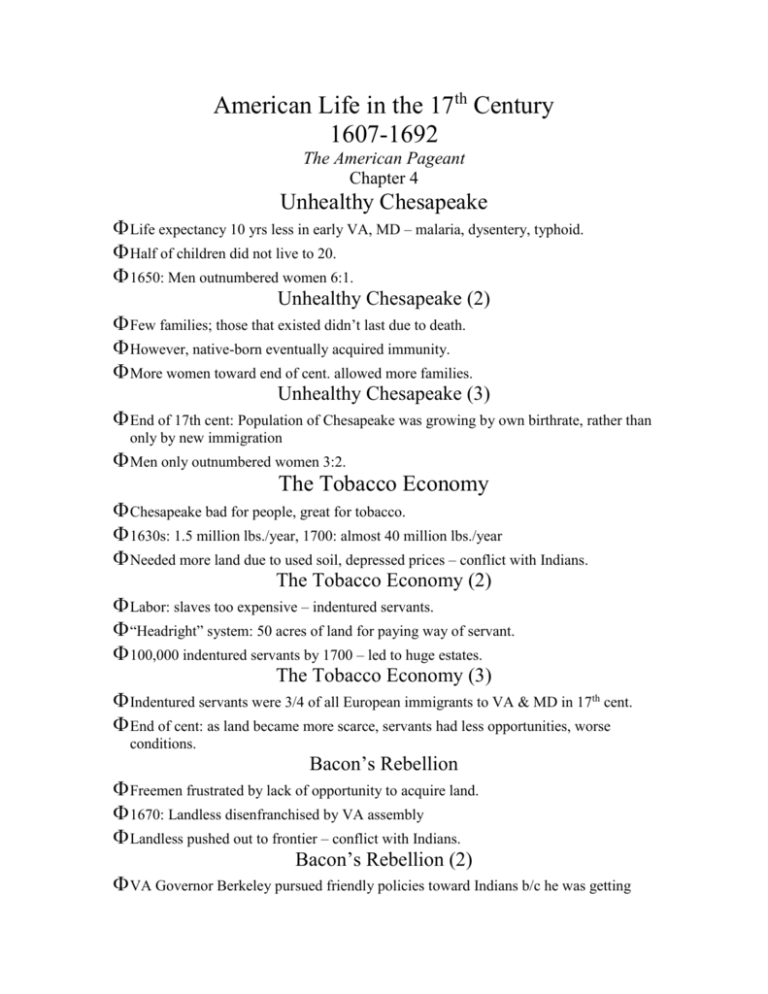
American Life in the 17th Century 1607-1692 The American Pageant Chapter 4 Unhealthy Chesapeake Life expectancy 10 yrs less in early VA, MD – malaria, dysentery, typhoid. Half of children did not live to 20. 1650: Men outnumbered women 6:1. Unhealthy Chesapeake (2) Few families; those that existed didn’t last due to death. However, native-born eventually acquired immunity. More women toward end of cent. allowed more families. Unhealthy Chesapeake (3) End of 17th cent: Population of Chesapeake was growing by own birthrate, rather than only by new immigration Men only outnumbered women 3:2. The Tobacco Economy Chesapeake bad for people, great for tobacco. 1630s: 1.5 million lbs./year, 1700: almost 40 million lbs./year Needed more land due to used soil, depressed prices – conflict with Indians. The Tobacco Economy (2) Labor: slaves too expensive – indentured servants. “Headright” system: 50 acres of land for paying way of servant. 100,000 indentured servants by 1700 – led to huge estates. The Tobacco Economy (3) Indentured servants were 3/4 of all European immigrants to VA & MD in 17th cent. End of cent: as land became more scarce, servants had less opportunities, worse conditions. Bacon’s Rebellion Freemen frustrated by lack of opportunity to acquire land. 1670: Landless disenfranchised by VA assembly Landless pushed out to frontier – conflict with Indians. Bacon’s Rebellion (2) VA Governor Berkeley pursued friendly policies toward Indians b/c he was getting rich on fur trade with them. 1676: About 1,000 Virginians, led by Nathaniel Bacon rebelled. Bacon’s Rebellion (3) 1676 Rebellion: murdered Indians, chased Berkeley from Jamestown, burned capital, etc. Bacon died of disease, Berkeley crushed rebellion, hung 20. Planters looked for less troublesome labor Colonial Slavery Of 10 million slaves to New World, only 400,000 came to North America. 1680s: rising wages in England resulted in fewer ind. servants. Planters fearful of mutinous former servants. Colonial Slavery (2) Mid 1680s: more black slaves than white servants were coming to plantation colonies. 1750: Blacks were 1/2 pop. of VA, in SC they outnumbered whites 2:1. Colonial Slavery (3) Most slaves came from W. Africa, captured and sold by African coastal tribes. “Middle Passage”: packed into ships to cross Atlantic – some death rates as high as 20%. “Slave codes”: difference Colonial Slavery (4) between slaves & white servants – black slaves and their children were property (“chattels”) for life. Could not teach them to read/ write Africans in America In deeper south (Carolinas), unhealthy climate and hard labor on rice & indigo plantations resulted in high death rates for slaves. Only new imports could sustain population. Africans in America (2) Chesapeake better for slaves: labor less demanding, planta-tions closer allowing more contact with friends, relatives 1720: # of female slaves allowed pop. growth through birth. Africans in America (3) Stable/distinctive slave culture developed. Contributions: religious dance that led to jazz, banjo, bongo drum, words (goober, gumbo, voodoo). Africans in America (4) A few slave rebellions: 1712 in NYC, 1739 in SC, but none to scale of Bacon’s Rebellion. Blacks proved a much more manageable labor force Southern Society Social pyramid: At the top the great planters, esp. “FFVs.” 2nd: small farmers – largest 3rd: landless whites (former indentured servants) 4th: black slaves Southern Society (2) Few cities, so no urban/ professional class. Southern life revolved around great plantations. Waterways were primary means of transportation. New England Family Clean water and cold weather added 10 yrs of life expectancy. New Englanders migrated as families - almost immediate natural increase in pop. Early marriage, continual childbirth (avg. 10 preg., 8 kids) New England Family (2) Family stability resulted in low premarital preg. rates (unlike Chesapeake), strong social structure. Few property rights for women, laws sought to defend marriage (Scarlet Letter). New England Town Life Society centered around small villages/farms & Puritan unity of purpose. Planned growth: new towns legally chartered, land distributed (contrast with Chesapeake). New England Town Life (2) Education: town of 50 families must provide elementary education, Harvard est. 1636. Congregational church led naturally to democratic town meeting (Jefferson: “best school of political liberty…”). 1/2-Way Cov./Witch Trials 1st generation’s Puritan zeal diluted over time. Mid 1600s: “Jeremiad” – popular sermon of warning Problem of declining church membership. 1/2-Way Cov./Witch Trials (2) 1662: Half-Way Covenant – partial membership to those not yet converted (usually children/ grandchildren of members). Eventually all welcomed to church, erased distinction of “elect.” 1/2-Way Cov./Witch Trials (3) 1692: group of adolescent girls in Salem, Mass. claimed bewitching by certain older women. Trials conducted, 20 people executed (+ 2 dogs). 1/2-Way Cov./Witch Trials (4) 1693: Witch hysteria ended with accusation of governor’s wife. Trials ended, pardons given. Accused were merchant elite, accusers were poorer farmers. Evidence suggest “witch hunt” based on social resentments. New England Way of Life Rocky soil: emphasis on hard work & frugality; less ethnically mixed b/c immigrants not attracted to soil. Soil & climate encouraged diversified agriculture & industry. New England Way of Life (2) Unlike Indians, English felt duty to “improve” land by clearing forests for farming/ pasture, building roads, etc. Due to soil, they became experts in shipbuilding, commerce & codfish. New England Way of Life (3) Calvinism, soil, climate produced energy, purposeful-ness, self-reliance, resourcefulness, (“Yankee ingenuity”). “New England conscience” from Puritans inspired later reformers (abolitionists). Early Settlers’ Ways Women: wove, cooked, cleaned, children; Men: cleared land, fenced, planted, cropped, firewood, butchered livestock. Compared to 17th cent. Europeans, Americans were fairly affluent. Early Settlers’ Ways (2) B/c “Dukes don’t emigrate” and very poor can’t afford it, most immigrants were in between. Class distinctions less, esp. in New England & middle col. Efforts to reproduce stratified society mostly failed.
